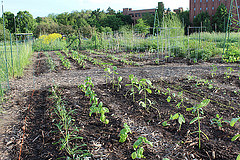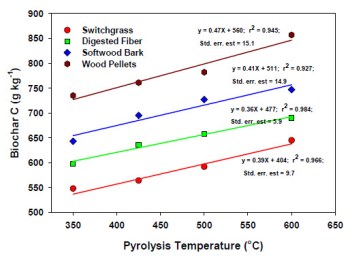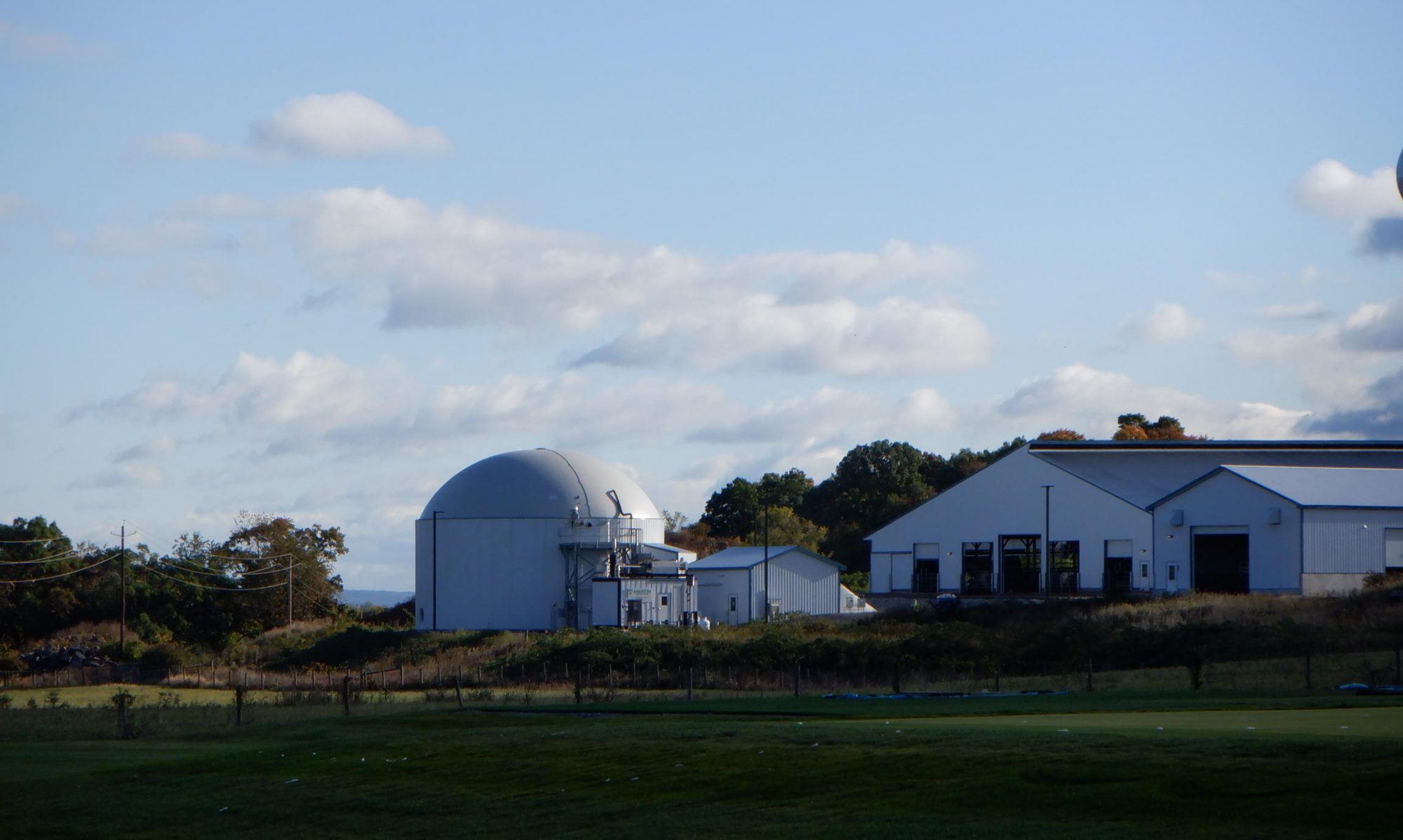There is a lot of interest in biochar as a soil amendment and for its potential role in sequestering carbon to ameliorate the effects of climate change. CenUSA is evaluating biochar impacts on farm and garden crops production. Research is active and ongoing, and this list of recommended readings provides links to publications about different aspects of biochar production and use.
Please note that most of these links go to abstracts provided by professional journals; many of the full articles are only available to subscribers, or for a fee. You may be able to access these publications at your university or college library.
Contents
The Impact of Biochar on Plants
Biederman, Lori A.; Harpole, W. Stanley. 2013. Biochar and its effects on plant productivity and nutrient cycling: a meta-analysis. Global Change in Biology Bioenergy 5: 202-214. http://onlinelibrary.wiley.com/doi/10.1111/gcbb.12037/abstract
Brockhoff, S.R., Christians, N.E., Killorn, R.J., Horton, R., Davis, D.D., 2010. Physical and Mineral-Nutrition Properties of Sand-Based Turfgrass Root Zones Amended with Biochar. Agron. J. 102, 1627-1631. https://www.agronomy.org/publications/aj/abstracts/102/6/1627?access=0&view=pdf

Busch, Daniela, Claudia Kammann, Ludger Grünhage and Christoph Müller. 2012.
Simple Biotoxicity Tests for Evaluation of Carbonaceous Soil Additives: Establishment and Reproducibility of Four Test Procedures. J. Environmental Quality 41:1023-1032. https://www.agronomy.org/publications/jeq/abstracts/41/4/1023
Buss, Wolfram, Claudia Kammann and Hans-Werner Koyro. 2012. Biochar Reduces Copper Toxicity in Chenopodium quinoa Willd. in a Sandy Soil. J. Environmental Quality 41:1157-1165. https://www.agronomy.org/publications/jeq/abstracts/41/4/1157
Crane-Droesch, A., Abiven, S., Jeffery, S., Torn, M.S., 2013. Heterogeneous global crop yield response to biochar: a meta-regression analysis. Environmental Research Letters 8, 044049. http://iopscience.iop.org/1748-9326/8/4/044049
Gajić, Ana and Heinz-Josef Koch. 2012. Sugar Beet ( Beta vulgaris L.) Growth Reduction Caused by Hydrochar Is Related to Nitrogen Supply. J. Environmental Quality 41:1067-1075. https://www.agronomy.org/publications/jeq/abstracts/41/4/1067
Glaser, Bruno and Jago Jonathan Birk. 2012. State of the scientific knowledge on properties and genesis of Anthropogenic Dark Earths in Central Amazonia (terra preta de Indio). Geochimica et Cosmochimica Acta 82: 39-51. http://www.sciencedirect.com/science/article/pii/S001670371100144X
Glaser, B., Haumaier, L., Guggenberger, G., Zech, W., 2001. The ‘Terra Preta’ phenomenon: a model for sustainable agriculture in the humid tropics. Naturwissenschaften 88, 37-41. http://link.springer.com/article/10.1007/s001140000193
Jeffery, S., F. G. A. Verheijen, M. van der Velde, and A.C. Bastos. 2011. A quantitative review of the effects of biochar application to soils on crop productivity using meta-analysis. Agriculture Ecosystems & Environment 144: 175-187. http://www.sciencedirect.com/science/article/pii/S0167880911003197
Kirwan, R., 1793. What are the manures most advantageously applicable to the various sorts of soils, and what are the causes of their beneficial effect in each particular instance? The Transactions of the Royal Irish Academy 5, 129-198. http://www.jstor.org/stable/30078693
Laird, David A., Natalia P. Rogovska, Manuel Garcia-Perez, Harold P. Collins, Jason D. Streubel, Matthew Smith, R. 2011. Pyrolysis and Biochar – Opportunities for Distributed Production and Soil Quality Enhancement. In: Ross Braun, Douglas L. Karlen, and Dewayne Johnson (editors) Sustainable Alternative Fuel Feedstock Opportunities, Challenges and Roadmaps for Six U.S. Regions. Proceedings of the Sustainable Feedstocks for Advanced Biofuel Workshop. SWCS publisher. http://www.swcs.org/documents/resources/Chapter_16__Laird__Pyrolysis_and_Bi_96E09F2679C2B.pdf
Lentz, R. D. and J. A. Ippolito. 2012. Biochar and Manure Affect Calcareous Soil and Corn Silage Nutrient Concentrations and Uptake. J. Environmental Quality 41:1033-1043. https://www.agronomy.org/publications/jeq/abstracts/41/4/1033
Ogawa, M., Okimori, Y., 2010. Pioneering works in biochar research, Japan. Soil Res. 48, 489-500. http://www.publish.csiro.au/?act=view_file&file_id=SR10006.pdf
Rogovska, N., Laird D., Cruse R. M., Trabue S., and Heaton E. 2012. Germination Tests for Assessing Biochar Quality. J. Environmental Quality 41: 1014-1022. https://www.agronomy.org/publications/jeq/abstracts/41/4/1014
Schnell, Ronnie W., Donald M. Vietor, Tony L. Provin, Clyde L. Munster and Sergio Capareda.2012. Capacity of Biochar Application to Maintain Energy Crop Productivity: Soil Chemistry, Sorghum Growth, and Runoff Water Quality Effects. J. Environmental Quality 41:1044-1051. https://www.agronomy.org/publications/jeq/abstracts/41/4/1044
Spokas, K.A., Cantrell, K.B., Novak, J.M., Archer, D.W., Ippolito, J.A., Collins, H.P., Boateng, A.A., Lima, I.M., Lamb, M.C., McAloon, A.J., Lentz, R.D., Nichols, K.A., 2012. Biochar: A synthesis of its agronomic impact beyond carbon sequestration. Journal of Environmental Quality 41, 973-989. https://www.agronomy.org/publications/jeq/abstracts/41/4/973
Stavi, Ilan and Rattan Lal. 2013. Agroforestry and biochar to offset climate change: a review. Agronomy for Sustainable Development 33: 81-96. http://link.springer.com/article/10.1007/s13593-012-0081-1
Tryon, E.H., 1948. Effect of charcoal on certain physical, chemical, and biological properties of forest soils. Ecol. Monogr 18, 81-115.ftp://ftp.dpvta.uniud.it/peressotti/Biochar/20 centries/US-Tryon1948-Effect of charcoal on certain physical, chemical, and biological properties of forest soils.pdf
The Impact of Biochar on Soils
Augustenborg, Cara A., Simone Hepp, Claudia Kammann, David Hagan, Olaf Schmidt and Christoph Müller. 2012. Biochar and Earthworm Effects on Soil Nitrous Oxide and Carbon Dioxide Emissions. J. Environmental Quality 41:1203-1209. https://www.agronomy.org/publications/jeq/abstracts/41/4/1203
 Basso, A. S., Miguez, F. E., Laird, D. A., Horton, R., & Westgate, M. (2013). Assessing potential of biochar for increasing water-holding capacity of sandy soils. GCB Bioenergy, 5(2), 132-143.http://onlinelibrary.wiley.com/doi/10.1111/gcbb.12026/full
Basso, A. S., Miguez, F. E., Laird, D. A., Horton, R., & Westgate, M. (2013). Assessing potential of biochar for increasing water-holding capacity of sandy soils. GCB Bioenergy, 5(2), 132-143.http://onlinelibrary.wiley.com/doi/10.1111/gcbb.12026/full
Biederman, Lori A.; Harpole, W. Stanley. 2013. Biochar and its effects on plant productivity and nutrient cycling: a meta-analysis. Global Change in Biology Bioenergy 5: 202-214. http://onlinelibrary.wiley.com/doi/10.1111/gcbb.12037/abstract
Brewer, Catherine E., Yan-Yan Hu, Klaus Schmidt-Rohr, Thomas E. Loynachan, David A. Laird and Robert C. Brown. 2012. Extent of Pyrolysis Impacts on Fast Pyrolysis Biochar Properties. J. Environmental Quality 41:1115-1122. https://www.agronomy.org/publications/jeq/abstracts/41/4/1115
Brockhoff, S.R., Christians, N.E., Killorn, R.J., Horton, R., Davis, D.D., 2010. Physical and Mineral-Nutrition Properties of Sand-Based Turfgrass Root Zones Amended with Biochar. Agron. J. 102, 1627-1631. https://www.agronomy.org/publications/aj/abstracts/102/6/1627?access=0&view=pdf
Buss, Wolfram, Claudia Kammann and Hans-Werner Koyro. 2012. Biochar Reduces Copper Toxicity in Chenopodium quinoa Willd. in a Sandy Soil. J. Environmental Quality 41:1157-1165. https://www.agronomy.org/publications/jeq/abstracts/41/4/1157
Choppala, G. K., N.S. Bolan, M. Megharaj, Z. Chen and R. Naidu. 2012. The Influence of Biochar and Black Carbon on Reduction and Bioavailability of Chromate in Soils. J. Environmental Quality 41:1175-1184. https://www.agronomy.org/publications/jeq/abstracts/41/4/1175
Crane-Droesch, A., Abiven, S., Jeffery, S., Torn, M.S., 2013. Heterogeneous global crop yield response to biochar: a meta-regression analysis. Environmental Research Letters 8, 044049. http://iopscience.iop.org/1748-9326/8/4/044049
Gajić, Ana and Heinz-Josef Koch. 2012. Sugar Beet ( Beta vulgaris L.) Growth Reduction Caused by Hydrochar Is Related to Nitrogen Supply. J. Environmental Quality 41:1067-1075. https://www.agronomy.org/publications/jeq/abstracts/41/4/1067
Glaser, B., Haumaier, L., Guggenberger, G., Zech, W., 2001. The ‘Terra Preta’ phenomenon: a model for sustainable agriculture in the humid tropics. Naturwissenschaften 88, 37-41. http://link.springer.com/article/10.1007/s001140000193
Hass, Amir, Javier M. Gonzalez, Isabel M. Lima, Harry W. Godwin, Jonathan J. Halvorson and Douglas G. Boyer. 2012. Chicken Manure Biochar as Liming and Nutrient Source for Acid Appalachian Soil. J. Environmental Quality 41:1096-1106. https://www.agronomy.org/publications/jeq/abstracts/41/4/1096
Granatstein, D., Kruger, C., Collins, H., Garcia-Perez, M., Yoder, J; Center for Sustaining Agriculture and Natural Resources Washington State University. 2009. Use of Biochar from the Pyrolysis of Waste Organic Material as a Soil Amendment. https://fortress.wa.gov/ecy/publications/publications/0907062.pdf
Ippolito, J. A., J. M. Novak, W. J. Busscher, M. Ahmedna, D. Rehrah and D. W. Watts. 2012. Switchgrass Biochar Affects Two Aridisols. J. Environmental Quality 41:1123-1130. https://www.agronomy.org/publications/jeq/abstracts/41/4/1123
Jeong, Chang Yoon, Jim J. Wang, Syam K. Dodla, Thomas L. Eberhardt and Les Groom. 2012. Effect of Biochar Amendment on Tylosin Adsorption–Desorption and Transport in Two Different Soils. J. Environmental Quality 41:1185-1192. https://www.agronomy.org/publications/jeq/abstracts/41/4/1185
Johnson, Jane M.F., Francisco J. Arriaga, Gary M. Banowetz, David R. Huggins, David Laird, Michael J. Ottman, Brian J. Wienhold. 2011. Crop Residues of the Contiguous United States: Balancing feedstock and soil needs with conservation tillage, cover crops, and biochar. In: Ross Braun, Douglas L. Karlen, and Dewayne Johnson (editors) Sustainable Alternative Fuel Feedstock Opportunities, Challenges and Roadmaps for Six U.S. Regions. Proceedings of the Sustainable Feedstocks for Advanced Biofuel Workshop. SWCS publisher. www.swcs.org/roadmap
Johnson, J.M.F., W.W. Wilhelm, D.L. Karlen, D.W. Archerd, B. Wienhold, D.T. Lightle, D. Laird, J. Baker, T.E. Ochsner, J.M. Novak, A.D. Halvorson, F. Arriaga, N.W. Barboura. 2010. Nutrient removal as function of corn stover cutting height and cob harvest. Biomass Res 3:342-352. http://link.springer.com/article/10.1007/s12155-010-9093-3
Kameyama, K., T. Miyamoto, T. Shiono and Y. Shinogi. 2012. Influence of Sugarcane Bagasse-derived Biochar Application on Nitrate Leaching in Calcaric Dark Red Soil. J. Environmental Quality 41:1131-1137. https://www.agronomy.org/publications/jeq/abstracts/41/4/1131
Kirwan, R., 1793. What are the manures most advantageously applicable to the various sorts of soils, and what are the causes of their beneficial effect in each particular instance? The Transactions of the Royal Irish Academy 5, 129-198. http://www.jstor.org/stable/30078693
Laird, D.A., P.D. Fleming, D.D. Davis, R. Horton, B. Wang, and D.L. Karlen. 2010a. Impact of biochar amendments on the quality of a typical Midwestern agricultural soil. Geoderma 158:443-449. http://www.sciencedirect.com/science/article/pii/S001670611000176X
Laird, D.A., P.D. Fleming, D.L. Karlen, B. Wang, R. Horton. 2010b. Biochar impact on nutrient leaching from a Midwestern agricultural soil. Geoderma 158:436-442. http://gaiainternational.org/wp-content/uploads/2014/03/biocharnutrientleachingmidwesternsoils1.pdf
Laird, David A., Natalia P. Rogovska, Manuel Garcia-Perez, Harold P. Collins, Jason D. Streubel, Matthew Smith, R. 2011. Pyrolysis and Biochar – Opportunities for Distributed Production and Soil Quality Enhancement. In: Ross Braun, Douglas L. Karlen, and Dewayne Johnson (editors) Sustainable Alternative Fuel Feedstock Opportunities, Challenges and Roadmaps for Six U.S. Regions. Proceedings of the Sustainable Feedstocks for Advanced Biofuel Workshop. SWCS publisher. http://www.swcs.org/documents/resources/Chapter_16__Laird__Pyrolysis_and_Bi_96E09F2679C2B.pdf
Lee, James W., M. Kidder, B.R. Evans, S. Paik, A.C. Buchanan, C.T. Garten, R.C. Brown, RC. 2010. Characterization of Biochars Produced from Cornstovers for Soil Amendment. Environmental Science & Technology. 44: 7970-7974. DOI: 10.1021/es101337x http://pubs.acs.org/doi/full/10.1021/es101337x
Lehmann, J., 2007. Bio-energy in the black. Front. Ecol. Environ. 5, 381-387. http://www.esajournals.org/doi/abs/10.1890/1540-9295(2007)5%5B381:BITB%5D2.0.CO;2
Lehmann, J., C. Czimczik, D. Laird, and S. Sohi. 2009. Chapter 11: Stability of Biochar in Soil. pp 169-182. In J. Lehmann and J. Stephen (eds.). Biochar for Environmental Management. Earthscan. http://books.google.com/books?id=w-CUty_JIfcC&pg=PA183&source=gbs_toc_r&cad=4#v=onepage&q&f=false
Lentz, R. D. and J. A. Ippolito. 2012. Biochar and Manure Affect Calcareous Soil and Corn Silage Nutrient Concentrations and Uptake. J. Environmental Quality 41:1033-1043. https://www.agronomy.org/publications/jeq/abstracts/41/4/1033
Libra, J.A., Ro, K.S., Kammann, C., Funke, A., Berge, N.D., Neubauer, Y., Titirici, M.-M., Fühner, C., Bens, O., Kern, J., Emmerich, K.-H., 2011. Hydrothermal carbonization of biomass residuals: a comparative review of the chemistry, processes and applications of wet and dry pyrolysis. Biofuels 2, 71-106. http://karlheinzemmerich.de/Dokumente/HTC_Review_Biofuels_2011.pdf
Major, Julie, Marco Rondon, Diego Molina, Susan J. Riha and Johannes Lehmann. 2012. Nutrient Leaching in a Colombian Savanna Oxisol Amended with Biochar. J. Environmental Quality 41:1076-1086. https://www.agronomy.org/publications/jeq/abstracts/41/4/1076
Novak, J.M. W.J. Busscher, D.L. Laird, M. Ahmedna, D.W. Watts, and M.A.S. Niandou. 2009. Impact of biochar amendment on fertility of a Southeastern Coastal Plain soil. Soil Science 174:105-112. http://journals.lww.com/soilsci/Abstract/2009/02000/Impact_of_Biochar_Amendment_on_Fertility_of_a.6.aspx
Novak, J.M., W.J. Busscher, D.W. Watts, D.A. Laird, M.A. Ahmedna, M.A.S. Niandou. 2010. Short-term CO2 mineralization after additions of biochar and switchgrass to a Typic Kandiudult. Geoderma 154:281-288. http://www.sciencedirect.com/science/article/pii/S0016706109003322
Novak, J.M., Busscher, W.J., Watts, D.W., Amonette, J.E., Ippolito, J.A., Lima, I.M., Gaskin, J., Das, K.C., Steiner, C., Ahmedna, M., Rehrah, D., Schomberg, H., 2012. Biochars Impact on Soil-Moisture Storage in an Ultisol and Two Aridisols. Soil Sci 177, 310-320. http://eprints.nwisrl.ars.usda.gov/1523/
Novak, J.M., Watts, D.W., 2013. Augmenting soil water storage using uncharred switchgrass and pyrolyzed biochars. Soil Use Manage 29, 98-104. http://onlinelibrary.wiley.com/doi/10.1111/sum.12026/abstract
Ogawa, M., Okimori, Y., 2010. Pioneering works in biochar research, Japan. Soil Res. 48, 489-500. http://www.publish.csiro.au/?act=view_file&file_id=SR10006.pdf
Qayyum, Muhammad Farooq, Diedrich Steffens, Hans Peter Reisenauer and Sven Schubert. 2012. Kinetics of Carbon Mineralization of Biochars Compared with Wheat Straw in Three Soils. J. Environmental Quality 41:1210-1220. https://www.agronomy.org/publications/jeq/abstracts/41/4/1210
Rogovska, N., P.D. Fleming, D.A. Laird, R.M. Cruse, T.B. Parkin, and D. Meek. 2011. Impact of biochar on manure carbon stabilization and greenhouse gas emissions. Soil Sci. Soc. Am. J. 75:871-879. https://www.soils.org/publications/sssaj/abstracts/75/3/871
Sarkhot, Deoyani V., Asmeret Asefaw Berhe and Teamrat A. Ghezzehei .2012. Impact of Biochar Enriched with Dairy Manure Effluent on Carbon and Nitrogen Dynamics. J. Environmental Quality 41:1107-1114. https://www.agronomy.org/publications/jeq/abstracts/41/4/1107
Schnell, Ronnie W., Donald M. Vietor, Tony L. Provin, Clyde L. Munster and Sergio Capareda.2012. Capacity of Biochar Application to Maintain Energy Crop Productivity: Soil Chemistry, Sorghum Growth, and Runoff Water Quality Effects. J. Environmental Quality 41:1044-1051. https://www.agronomy.org/publications/jeq/abstracts/41/4/1044
Schomberg, Harry H., Julia W. Gaskin, Keith Harris, K.C. Das, Jeff M. Novak, Warren J. Busscher, Don W. Watts, Robin H. Woodroof, Isabel M. Lima, Mohamed Ahmedna, Djaafar Rehrah and Baoshan Xing. 2012. Influence of Biochar on Nitrogen Fractions in a Coastal Plain Soil. J. Environmental Quality 41:1087-1095. https://www.agronomy.org/publications/jeq/abstracts/41/4/1087
Sohi, S. P.; E. Krull, E. Lopez-Capel, R. Bol and E. Krull. 2010. A Review of Biochar and Its Use and Function in Soil. Advances in Agronomy 105: 47-52. http://www.sciencedirect.com/science/article/pii/S0065211310050029
Tryon, E.H., 1948. Effect of charcoal on certain physical, chemical, and biological properties of forest soils. Ecol. Monogr 18, 81-115. ftp://ftp.dpvta.uniud.it/peressotti/Biochar/20 centries/US-Tryon1948-Effect of charcoal on certain physical, chemical, and biological properties of forest soils.pdf
Uchimiya, Minori, Keri B. Cantrell, Patrick G. Hunt, Jeffrey M. Novak and SeChin Chang. 2012. Retention of Heavy Metals in a Typic Kandiudult Amended with Different Manure-based Biochars. J. Environmental Quality 41:1138-1149. https://www.agronomy.org/publications/jeq/abstracts/41/4/1138
Wilhelm, W.W., J.M.F. Johnson, D.T. Lightle, N.W. Barbour, D.L. Karken, J.M. Novak, N.W. Barbour, D.A. Laird, J.M. Baker, T.E. Ochsner, A.D. Halvorson, D.W. Archer, and F.J. Arriaga. 2011. Vertical Distribution of Corn Stover Dry Mass Grown at Several U.S. Locations. Bioenerg. Res. (2011) 4:11–21. http://link.springer.com/article/10.1007%2Fs12155-010-9097-z
Yoo, Gayoung and Hojeong Kang. 2012. Effects of Biochar Addition on Greenhouse Gas Emissions and Microbial Responses in a Short-Term Laboratory Experiment. J. Environmental Quality 41:1193-1202. https://www.agronomy.org/publications/jeq/abstracts/41/4/1193
Zimmerman, A.R., 2010. Abiotic and Microbial Oxidation of Laboratory-Produced Black Carbon (Biochar). Environmental Science & Technology 44, 1295-1301. http://pubs.acs.org/doi/abs/10.1021/es903140c
Zimmerman, A.R., Gao, B., Ahn, M.-Y., 2011. Positive and negative carbon mineralization priming effects among a variety of biochar-amended soils. Soil Biology and Biochemistry 43, 1169-1179. http://www.sciencedirect.com/science/article/pii/S0038071711000769#
Biochar Manufacturing
 Relationship between pyrolysis temperature and the C concentration of the resulting biochar. Figure from Granatstein et al., 2009
Relationship between pyrolysis temperature and the C concentration of the resulting biochar. Figure from Granatstein et al., 2009

Abdullah, H., Mediaswanti, K.A., Wu, H., 2010. Biochar as a Fuel: 2. Significant Differences in Fuel Quality and Ash Properties of Biochars from Various Biomass Components of Mallee Trees. Energy & Fuels 24, 1972-1979. http://pubs.acs.org/doi/abs/10.1021/ef901435f?journalCode=enfuem
Kauffman N., D. Hayes, R. Brown. 2011. A life cycle assessment of advanced biofuel production from a hectare of corn. FUEL 90: 3306-3314. http://www.sciencedirect.com/science/article/pii/S0016236111003498
Laird, David A., Natalia P. Rogovska, Manuel Garcia-Perez, Harold P. Collins, Jason D. Streubel, Matthew Smith, R. 2011. Pyrolysis and Biochar – Opportunities for Distributed Production and Soil Quality Enhancement. In: Ross Braun, Douglas L. Karlen, and Dewayne Johnson (editors) Sustainable Alternative Fuel Feedstock Opportunities, Challenges and Roadmaps for Six U.S. Regions. Proceedings of the Sustainable Feedstocks for Advanced Biofuel Workshop. SWCS publisher. http://www.swcs.org/documents/resources/Chapter_16__Laird__Pyrolysis_and_Bi_96E09F2679C2B.pdf
Biochar Properties
Abdullah, H., Mediaswanti, K.A., Wu, H., 2010. Biochar as a Fuel: 2. Significant Differences in Fuel Quality and Ash Properties of Biochars from Various Biomass Components of Mallee Trees. Energy & Fuels 24, 1972-1979. http://pubs.acs.org/doi/abs/10.1021/ef901435f?journalCode=enfuem
Bapat, H.D., Manahan, S.E., 1998. Chemchar gasification of hazardous wastes and mixed wastes on a biochar matrix. Abstracts of Papers of the American Chemical Society 215, 008-ENVR. http://www.biochar-international.org/node/915
Brewer, Catherine E., Yan-Yan Hu, Klaus Schmidt-Rohr, Thomas E. Loynachan, David A. Laird and Robert C. Brown. 2012. Extent of Pyrolysis Impacts on Fast Pyrolysis Biochar Properties. J. Environmental Quality 41:1115-1122. https://www.agronomy.org/publications/jeq/abstracts/41/4/1115

Bridgwater, A., 2003. Renewable fuels and chemicals by thermal processing of biomass. Chemical Engineering Journal 91, 87-102. http://www.sciencedirect.com/science/article/pii/S1385894702001420
Budai, A., Zimmerman, A., Cowie, A., Webber, J., Singh, B., Glaser, B., Masiello, C., Andersson, D., Shields, F., Lehmann, J., 2013. Biochar Carbon Stability Test Method: An Assessment of Methods To Determine Biochar Carbon Stability, 2013. in: (IBI), I.B.I. (Ed.), Westerville, OH, USA. http://www.biochar-international.org/sites/default/files/IBI_Report_Biochar_Stability_Test_Method_Final.pdf
Busch, Daniela, Claudia Kammann, Ludger Grünhage and Christoph Müller. 2012. Simple Biotoxicity Tests for Evaluation of Carbonaceous Soil Additives: Establishment and Reproducibility of Four Test Procedures. J. Environmental Quality 41:1023-1032 https://www.agronomy.org/publications/jeq/abstracts/41/4/1023
Fidel, R. B., Laird, D. A., & Thompson, M. L. 2013. Evaluation of Modified Boehm Titration Methods for Use with Biochars. J. Environmental Quality, 42: 1771-1778. https://www.agronomy.prg/publications/jeq/abstracts/42/6/1771
Gray, M., Johnson, M.G., Dragila, M.I., Kleber, M., 2014. Water uptake in biochars: The roles of porosity and hydrophobicity. Biomass Bioenerg 61, 196-205. http://www.sciencedirect.com/science/article/pii/S0961953413005230#
Ippolito, J. A., D. G. Strawn, K. G. Scheckel, J. M. Novak, M. Ahmedna and M. A. S. Niandou. 2012. Macroscopic and Molecular Investigations of Copper Sorption by a Steam-Activated Biochar. J. Environmental Quality 41:1150-1156. https://www.agronomy.org/publications/jeq/abstracts/41/4/1150
Jones, T.P., Chaloner, W.G., Kuhlbusch, T.A.G., 1997. Proposed Biogeological and Chemical Based Terminology for Fire-Altered Plant Matter. Springer-Verlag, Berlin. http://link.springer.com/chapter/10.1007/978-3-642-59171-6_2
Kloss, Stefanie, Franz Zehetner, Alex Dellantonio, Raad Hamid, Franz Ottner, Volker Liedtke, Manfred Schwanninger, Martin H. Gerzabek and Gerhard Soja. 2012.Characterization of Slow Pyrolysis Biochars: Effects of Feedstocks and Pyrolysis Temperature on Biochar Properties. J. Environmental Quality 41:990-1000 https://www.agronomy.org/publications/jeq/abstracts/41/4/990
Laird, David A., Natalia P. Rogovska, Manuel Garcia-Perez, Harold P. Collins, Jason D. Streubel, Matthew Smith, R. 2011. Pyrolysis and Biochar – Opportunities for Distributed Production and Soil Quality Enhancement. In: Ross Braun, Douglas L. Karlen, and Dewayne Johnson (editors) Sustainable Alternative Fuel Feedstock Opportunities, Challenges and Roadmaps for Six U.S. Regions. Proceedings of the Sustainable Feedstocks for Advanced Biofuel Workshop. SWCS publisher. http://www.swcs.org/documents/resources/Chapter_16__Laird__Pyrolysis_and_Bi_96E09F2679C2B.pdf
Ogawa, M., Okimori, Y., 2010. Pioneering works in biochar research, Japan. Soil Res. 48, 489-500. http://www.publish.csiro.au/?act=view_file&file_id=SR10006.pdf
Rapp, G., 2009. Pigments and Colorants. Archaeomineralogy. Springer Berlin Heidelberg, pp. 201-221. http://link.springer.com/chapter/10.1007%2F978-3-540-78594-1_9
Schimmelpfennig, Sonja and Bruno Glaser. 2012. One Step Forward toward Characterization: Some Important Material Properties to Distinguish Biochars. J. Environmental Quality 41:1001-1013. https://www.agronomy.org/publications/jeq/abstracts/41/4/1001
Streubel, Jason D., Harold P. Collins, Julie M. Tarara and Rebecca L. Cochran. 2012. Biochar Produced from Anaerobically Digested Fiber Reduces Phosphorus in Dairy Lagoons. J. Environmental Quality 41:1166-1174. https://www.agronomy.org/publications/jeq/abstracts/41/4/1166
Wiedner, Katja, Cornelia Rumpel, Christoph Steiner, Alessandro Pozzi, Robert Maas, and Bruno Glaser. 2013. Chemical evaluation of chars produced by thermochemical conversion (gasification, pyrolysis and hydrothermal carbonization) of agro-industrial biomass on a commercial scale. Boimass & Bioenergy 59: 264-278. http://www.sciencedirect.com/science/article/pii/S0961953413003723
Biochar’s Role in Carbon Sequestration, Greenhouse Gases, and Climate Change
Allen, R. M., & Laird, D. A. (2013). Quantitative Prediction of Biochar Soil Amendments by Near-Infrared Reflectance Spectroscopy. Soil Science Society of America Journal, 77(5), 1784-1794. https://www.soils.org.publications/sssaj/abstracts/77/5/1784?access=0&view=pdf
Augustenborg, Cara A., Simone Hepp, Claudia Kammann, David Hagan, Olaf Schmidt and Christoph Müller. 2012. Biochar and Earthworm Effects on Soil Nitrous Oxide and Carbon Dioxide Emissions. J. Environmental Quality 41:1203-1209. https://www.agronomy.org/publications/jeq/abstracts/41/4/1203
Glaser, B., Haumaier, L., Guggenberger, G., Zech, W., 2001. The ‘Terra Preta’ phenomenon: a model for sustainable agriculture in the humid tropics. Naturwissenschaften 88, 37-41. http://link.springer.com/article/10.1007/s001140000193
Kammann, Claudia, Stefan Ratering, Christian Eckhard and Christoph Müller. 2012. Biochar and Hydrochar Effects on Greenhouse Gas (Carbon Dioxide, Nitrous Oxide, and Methane) Fluxes from Soils. J. Environmental Quality 41:1052-1066. https://www.agronomy.org/publications/jeq/abstracts/41/4/1052
Kauffman N., D. Hayes, R. Brown. 2011. A life cycle assessment of advanced biofuel production from a hectare of corn. FUEL 90: 3306-3314. http://www.sciencedirect.com/science/article/pii/S0016236111003498
Lehmann, J., 2007. Bio-energy in the black. Front. Ecol. Environ. 5, 381-387. http://www.esajournals.org/doi/abs/10.1890/1540-9295(2007)5%5B381:BITB%5D2.0.CO;2
Qayyum, Muhammad Farooq, Diedrich Steffens, Hans Peter Reisenauer and Sven Schubert. 2012. Kinetics of Carbon Mineralization of Biochars Compared with Wheat Straw in Three Soils. J. Environmental Quality 41:1210-1220. https://www.agronomy.org/publications/jeq/abstracts/41/4/1210
Rogovska, N., P.D. Fleming, D.A. Laird, R.M. Cruse, T.B. Parkin, and D. Meek. 2011. Impact of biochar on manure carbon stabilization and greenhouse gas emissions. Soil Sci. Soc. Am. J. 75:871-879. https://www.soils.org/publications/sssaj/abstracts/75/3/871
Stavi, Ilan and Rattan Lal. 2013. Agroforestry and biochar to offset climate change: a review. Agronomy for Sustainable Development 33: 81-96. http://link.springer.com/article/10.1007/s13593-012-0081-1
Woolf, Dominic, James E Amonette, F. Alayne Street-Perrott, Johannes Lehmann and Stephen Joseph. 2010. Sustainable biochar to mitigate global climate change. Nature Communications 1: 56. doi:10.1038/ncomms1053. http://www.nature.com/ncomms/journal/v1/n5/full/ncomms1053.html
Yoo, Gayoung and Hojeong Kang. 2012. Effects of Biochar Addition on Greenhouse Gas Emissions and Microbial Responses in a Short-Term Laboratory Experiment. J. Environmental Quality 41:1193-1202. https://www.agronomy.org/publications/jeq/abstracts/41/4/1193
Zimmerman, A.R., 2010. Abiotic and Microbial Oxidation of Laboratory-Produced Black Carbon (Biochar). Environmental Science & Technology 44, 1295-1301. http://pubs.acs.org/doi/abs/10.1021/es903140c
Zimmerman, A.R., Gao, B., Ahn, M.-Y., 2011. Positive and negative carbon mineralization priming effects among a variety of biochar-amended soils. Soil Biology and Biochemistry 43, 1169-1179. http://www.sciencedirect.com/science/article/pii/S0038071711000769#
Research Reviews and State of the Knowledge
Ahmad, Mahtab, Anushka Upamali Rajapaksha, Jung Eun Lim, Ming Zhang, Nanthi Bolan, Dinesh Mohan, Meththika Vithanage, Sang Soo Lee, Yong Sik Ok. Biochar as a sorbent for contaminant management in soil and water: A review. 2014 Chemosphere 99:19-33. http://www.sciencedirect.com/science/article/pii/S0045653513015051
Barrow, C. J 2012. Biochar: Potential for countering land degradation and for improving agriculture. Applied Geography 34: 21-28. http://www.sciencedirect.com/science/article/pii/S0143622811001780
Beesley, Luke, Eduardo Moreno-Jimenez, Jose L Gomez-Eyles, Eva Harris, Brett Robinson and Tom Sizmur. 2011. A review of biochars’ potential role in the remediation, revegetation and restoration of contaminated soils. Environmental Pollution. 159: 3269-3282. http://www.sciencedirect.com/science/article/pii/S0269749111003939
Biederman, Lori A.; Harpole, W. Stanley. 2013. Biochar and its effects on plant productivity and nutrient cycling: a meta-analysis. Global Change in Biology Bioenergy 5: 202-214. http://onlinelibrary.wiley.com/doi/10.1111/gcbb.12037/abstract
Glaser, Bruno and Jago Jonathan Birk. 2012. State of the scientific knowledge on properties and genesis of Anthropogenic Dark Earths in Central Amazonia (terra preta de Indio). Geochimica et Cosmochimica Acta 82: 39-51.http://www.sciencedirect.com/science/article/pii/S001670371100144X
Gurwick, Noel P., Lisa A.; Moore, Charlene Kelly, and Patricia Elias. 2013. A Systematic Review of Biochar Research, with a Focus on Its Stability in situ and Its Promise as a Climate Mitigation Strategy. Plos One DOI: 10.1371/journal.pone.0075932 http://www.plosone.org/article/info%3Adoi%2F10.1371%2Fjournal.pone.0075932
Ippolito, James A., David A. Laird and Warren J. Busscher. 2012 Environmental benefits of biochar. J. Environmental Quality 41:967-972. https://www.agronomy.org/publications/jeq/abstracts/41/4/967
Jirka, Stefan and Thayer Tomlinson. 2014. 2013 State of the Biochar Industry A Survey of Commercial Activity in the Biochar Field: Report Overview , A report from the International Biochar Initiative (IBI). http://www.biochar-international.org/sites/default/files/StateoftheBiocharIndustry_2013_4pager_final.pdf
Laird, D.A. 2008. The Charcoal Vision: A win-win-win scenario for simultaneously producing bioenergy, permanently sequestering carbon, while improving soil and water quality. Agronomy J. 100:178-181. http://naldc.nal.usda.gov/catalog/17624
Laird, David A., Robert C. Brown, James E. Amonette and Johannes Lehmann. 2009. Review of the pyrolysis platform for coproducing bio-oil and biochar Biofuels, Bioproducts and Biorefining 3, 547-562. http://www.css.cornell.edu/faculty/lehmann/publ/BiofBioproBioref 3, 547-562, 2009 Laird.pdf
Laird, David A. and Jeffrey M. Novak. 2011. Biochar and Soil Quality. In Encyclopedia of Soil Science, Second Edition. Taylor and Francis: New York, Published online: 06 Jan 2011; 1-4. http://www.tandfonline.com/doi/full/10.1081/E-ESS-120045816#.U6NUCLFBnOM
Laird, David A., Natalia P. Rogovska, Manuel Garcia-Perez, Harold P. Collins, Jason D. Streubel, Matthew Smith, R. 2011. Pyrolysis and Biochar – Opportunities for Distributed Production and Soil Quality Enhancement. In: Ross Braun, Douglas L. Karlen, and Dewayne Johnson (editors) Sustainable Alternative Fuel Feedstock Opportunities, Challenges and Roadmaps for Six U.S. Regions. Proceedings of the Sustainable Feedstocks for Advanced Biofuel Workshop. SWCS publisher. http://www.swcs.org/documents/resources/Chapter_16__Laird__Pyrolysis_and_Bi_96E09F2679C2B.pdf
Ogawa, M., Okimori, Y., 2010. Pioneering works in biochar research, Japan. Soil Res. 48, 489-500. http://www.publish.csiro.au/?act=view_file&file_id=SR10006.pdf
Spokas, K.A., Cantrell, K.B., Novak, J.M., Archer, D.W., Ippolito, J.A., Collins, H.P., Boateng, A.A., Lima, I.M., Lamb, M.C., McAloon, A.J., Lentz, R.D., Nichols, K.A., 2012. Biochar: A synthesis of its agronomic impact beyond carbon sequestration. J. Envioronmental Quality 41, 973-989. https://www.agronomy.org/publications/jeq/abstracts/41/4/973
Stavi, Ilan and Rattan Lal. 2013. Agroforestry and biochar to offset climate change: a review Agronomy for Sustainable Development 33: 81-96. http://link.springer.com/article/10.1007/s13593-012-0081-1
The Economics of Biochar
Brown T.R., M.M. Wright, R.C. Brown. 2011. Estimating profitability of two biochar production scenarios: slow pyrolysis vs fast pyrolysis. Biofuels Bioproducts & Biorefining 5: 54-68. http://onlinelibrary.wiley.com/doi/10.1002/bbb.254/abstract
Biomass Conversion
Brewer C.E., K. Schmidt-Rohr, J.A. Satrio, R.C. Brown. 2009. Characterization of Biochar from Fast Pyrolysis and Gasification Systems. Environmental Progress & Sustainable Energy. 28: 386-396. http://onlinelibrary.wiley.com/doi/10.1002/ep.10378/full
 Bridgwater, A.V., Meier, D., Radlein, D., 1999. An overview of fast pyrolysis of biomass. Organic Geochemistry 30, 1479-1493. http://www.sciencedirect.com/science/article/pii/S0146638099001205#
Bridgwater, A.V., Meier, D., Radlein, D., 1999. An overview of fast pyrolysis of biomass. Organic Geochemistry 30, 1479-1493. http://www.sciencedirect.com/science/article/pii/S0146638099001205#
Butuzova, L., Razvigorova, M., Krzton, A., Minkova, V., 1998. The effect of water on the yield and structure of the products of brown coal pyrolysis and hydrogenation. Fuel 77, 639-643. http://www.sciencedirect.com/science/article/pii/S0016236197002123#
Libra, J.A., Ro, K.S., Kammann, C., Funke, A., Berge, N.D., Neubauer, Y., Titirici, M.-M., Fühner, C., Bens, O., Kern, J., Emmerich, K.-H., 2011. Hydrothermal carbonization of biomass residuals: a comparative review of the chemistry, processes and applications of wet and dry pyrolysis. Biofuels 2, 71-106. http://karlheinzemmerich.de/Dokumente/HTC_Review_Biofuels_2011.pdf
Mullen, C.A., A.A. Boateng, N. Goldberg, I.M. Lima, D.A. Laird, and K.B. Hicks. 2010. Bio-oil and bio-char production from corn cobs and stover by fast pyrolysis. Biomass and Bioenergy. 34:67-74. http://www.sciencedirect.com/science/article/pii/S0961953409002037
Williams, P.T., Besler, S., 1996. The influence of temperature and heating rate on the slow pyrolysis of biomass. Renewable Energy 7, 233-250. http://www.sciencedirect.com/science/article/pii/0960148196000067#
Yaman, S., 2004. Pyrolysis of biomass to produce fuels and chemical feedstocks. Energy Conversion and Management 45, 651-671. http://www.sciencedirect.com/science/article/pii/S0196890403001778#
Yip, K., Wu, H., Zhang, D.-k., 2007. Effect of Inherent Moisture in Collie Coal during Pyrolysis Due to in-Situ Steam Gasification. Energy & Fuels 21, 2883-2891. http://pubs.acs.org/doi/abs/10.1021/ef7002443
Yu, F., Deng, S., Chen, P., Liu, Y., Wan, Y., Olson, A., Kittelson, D., Ruan, R., 2007. Physical and chemical properties of bio-oils from microwave pyrolysis of corn stover. Applied Biochemistry and Biotechnology 137-140, 957-970.http://link.springer.com/chapter/10.1007/978-1-60327-181-3_78
Zhang, Q., Chang, J., Wang, T., Xu, Y., 2007. Review of biomass pyrolysis oil properties and upgrading research. Energy Conversion and Management 48, 87-92. http://www.sciencedirect.com/science/article/pii/S0196890406001701#
CenUSA Bioenergy is a coordinated research and education effort investigating the creation of a regional system in the Central US for producing advanced transportation fuels from perennial grasses on land that is either unsuitable or marginal for row crop production.
In addition to producing advanced biofuels, the proposed system will improve the  sustainability of existing cropping systems by reducing agricultural runoff of nutrients in soil and increasing carbon sequestration. Research Partners lead by Iowa State University: USDA Agricultural Research Service (ARS), Purdue University, University of Illinois, University of Minnesota, University of Nebraska–Lincoln, University of Vermont, and University of Wisconsin
sustainability of existing cropping systems by reducing agricultural runoff of nutrients in soil and increasing carbon sequestration. Research Partners lead by Iowa State University: USDA Agricultural Research Service (ARS), Purdue University, University of Illinois, University of Minnesota, University of Nebraska–Lincoln, University of Vermont, and University of Wisconsin
CenUSA is supported by Agriculture and Food Research Initiative Competitive Grant no. 2011-68005-30411 from the USDA National Institute of Food and Agriculture.


